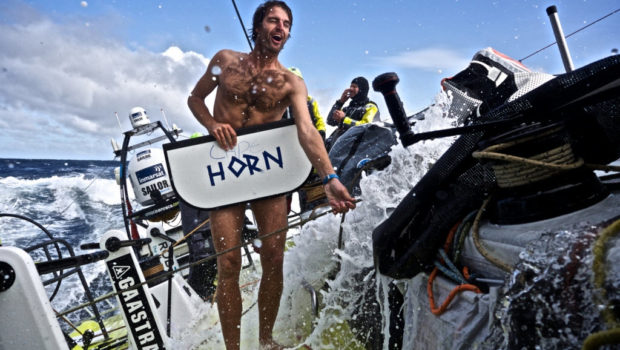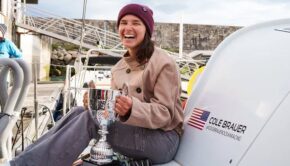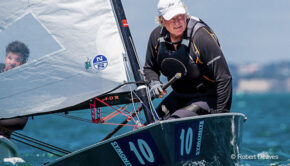Volvo Ocean Race: Yesterday, Today, Tomorrow
Published on October 16th, 2016
With the Volvo Ocean Race heading back into the Southern Ocean, Richard Mason, veteran round-the-world racer and now operations director of the Volvo Ocean Race, talks to Blue Robinson in the November issue of Seahorse magazine about the evolution of the event, breaking records, getting the real story off the boats…and the smart boat choice for 2020
Seahorse Magazine: Before the last race what were the big reasons for moving from the Volvo 70 over to the 65?
Richard Mason: Money. To be competitive, campaign costs and the cost of boat development were very, very high, which created an arms race, so that really drove the move to the 65. Of course it’s not just the boats – you now have shared economies in the rigging, the sails the equipment onboard, plus maintaining and running all this with a common shore team.
We are really starting to see the impact from that decision, the benefits of Nick Bice setting up the boatyard and of us now supplying everything to the teams.
SH: Was the last race essential to consolidating the event?
RM: Yes, I think so. It wasn’t an easy decision for Knut [Frostad], and I was on the other side of the fence. There was no question that we were pretty resistant in moving to one-design and were concerned at losing the design and development side, the evolution of sails, materials and rigs, but there was a very big cost associated with this and, with the economy pretty flat, it could be argued there may not have been a race had we not shifted to one-design.
Now we are in the one-design world and the last race proved highly successful; some of the finish deltas were unbelievable. So the focus of this next race is to maximize the benefits of one-design while getting the race back on a traditional course and doing everything we can to open up the racing. This means looking hard at things like ice gates, their location and should we even have them; the scoring; how do we manage the weather data the fleet receives, should there be times we don’t supply weather data at all and leave the crews on their own; the effects of AIS on the race. The boats stayed pretty close together last time so we are now looking at how to open up the options for navigators.
SH: How did the VO65 come through the last race?
RM: Looking at things from a structural standpoint, exceptionally well. We didn’t have one structural failure. In the old days we were fighting to get weight out of the boats and would almost be disappointed if we didn’t have some structural damage, as that meant we’d overbuilt it. Remember the 2011/12 race and the structural failures in the Auckland-Itajaí leg? At one point there was only one boat racing…
SH: So is the VO65 extreme enough?
RM: Great question. The boats don’t have anywhere near the righting moment of the VO70, even percentage-wise, so before they loaded them right up and got into trouble the 65 would tip over. So, yes, at times crews were looking for more power. The VO65s were certainly fit for the job, and as we look to the future we know the one-design concept works, so how do we take it forwards? This is a big conversation in our organisation right now. The fundamentals are good for a one-design event, it’s now a case of defining the best tool for blue water grand prix ocean racing.
SH: In the last event we had a women’s team that evolved well, nailing in-port races and winning a leg. What about the next race?
RM: It’s a key focus. One big challenge is to ensure we don’t lose the legacy of SCA, who proved beyond doubt how well women can perform given the opportunity. It’s also important to remember the reasons why women weren’t competing in the VOR. When I started my offshore career in the late 1990s there were a lot of prominent women involved, Mikaela von Koskull, Adrienne Cahalan, Lisa McDonald and others. Then we had a period in three editions of the race when you almost had to be a human tank as a crew member just to take the beatings on deck. On the 2008-09 race I was 105kg and I would regularly get washed off the wheel – we really struggled with the physical strength needed back then. The VO65 has largely taken that extreme strength element out.
SH: So will we see women racing in 2017?
RM: The odds on an all-women crew are slim, but a mixed crew, absolutely. We are working hard to revise the race rules to pretty much guarantee a mixed crew, which I believe would be a smart move for a team. Just remember how many starts Carolijn Brouwer nailed in the last race, particularly in the in-port races? She probably does a dozen starts a day in her Olympic campaign, we offshore guys do one every two months!
SH: How are entries looking?
RM: Medium to good. I can’t reveal much now but we are doing better than at this stage last time. One thing with the one design race is that you can enter quite late.
There have been some simple additions to the sail wardrobe for the next race but nothing too different. The boats will be refitted between October 2016 and April 2017 and as the boats come out of refit the new sails will be available; so teams can sail and train but they can’t do any VPP testing until May 2017. If you sailed the last race you already have the numbers, and with a strong team you can start sailing in April/May next year and you will be fine; you don’t have to carry out all of that extensive testing we used to do, proving the boat and developing stuff like furling and luff cable systems.
SH: That also influences the time the sailors need to be away from their regular regatta loop…
RM: Absolutely. We used to sign up for these campaigns for two years at a time, but now it’s quite difficult for guys to step out of a Maxi or TP52 programme and then get back in.
SH: The Vendée Globe has 30 skippers registered for this year’s race, an entry that is only ultimately limited by the size of the host port. Given that, how much of a challenge is it for the Volvo to remain the pinnacle of offshore sailing?
RM: Taking nothing away from the Vendée guys, it’s a different type of sport. They are ticking off close to 600-mile days on 60s with foils, which is incredible. The Vendée is the perfect mix of individual endeavour and technology, where one individual – often with a big team behind them – challenges the elements head on. The VOR is about getting a team around the world over nine months, with a more complex course and in-port elements. But we do need to investigate which boat we use in the 2020 race to ensure we remain at the pinnacle, and we also need to draw Vendée sailors into the VOR – and get some of our guys out in the Vendée.
SH: What about the VOR’s return to the Southern Ocean?
RM: Back to our roots, Blue! We have various cities interested in hosting the race and we had options on all of that – what order to visit those cities and whether you leave Australia to port or starboard. As soon as I saw the opportunity to put the race back in the Southern Ocean I grabbed it, with a lot of support from the guys around me. It’s simple, it’s where this race was born and it’s where we need to be.
To some extent we haven’t seen the full potential of the VO65s yet as they were crossing the Equator multiple times in the last race. It’s obviously very important we meet the demands of the commercial world but we must not lose the backbone of the race. An important part of that is to see the fleet back in the Southern Ocean. As I mentioned, we are looking at where the ice gates should be or if we just let the skippers decide. The first race I did in 2001-02 we went down to 61°S… which is land in the winter. I don’t think the fleet has seen an iceberg in the last two editions of the race; that will change.
SH: Cape Town to Hong Kong is a huge leg this time… How will it be won or lost?
RM: By finishing! It is going to be huge, the weight loss of the crews could play a role and they will also be jumping between climates. Straight out of Cape Town looking to hook into a front and try to get below the Kerguelens, then come up either through Bass Strait or the Tasman Sea.
Then they are into cyclone season, so could see some big heavy weather along the back of the Pacific Islands, then the Luzon Straits into Hong Kong which can be 50kt reaching. It is a long leg, with periods to recover in the Pacific, but keeping up the motivation and keeping some powder dry is key. It’s going to be 34-36 days at sea. But in the first race I did a 30-day leg was still quite usual.
SH: So the onboard media role will become even more critical to keeping up interest ashore…
RM: I can assure you that so far we haven’t got anywhere near more than 10 per cent of the good stuff off the boats. There is some amazing stuff that I guess has been protected by the teams – but those stories are seriously compelling. How is it we can sit and watch The Deadliest Catch, a documentary with guys pulling in lobster pots, why is that compelling? Because it’s a brutally hard human story. If the public really knew how hard the VOR was that would make some viewing. Also with the 360° cameras mounted onboard last time, it was the first time I watched sailing footage and got vertigo. We may also be going live to the boats for key periods, such as when a front hits – this is one of the big challenges. Make the race a tactical one for the sailors plus getting these key stories off; and while we’re doing that define the future of the race.
The VOR is the pinnacle of the sport but you could make a judgement that it has become less so in the past editions; we need to get it back up there with the best sailors on the planet taking part. I’m hoping that guys like Pete Burling and Blair Tuke, having nailed the Olympics and then competed in the America’s Cup, will maybe feel they haven’t quite got it until they’ve conquered a Volvo.
SH: How long do you think the VO65 will remain the weapon of choice?
RM: In a perfect world, just for this next edition. It’s an interesting point – what are the challenges for commercial partnerships, for the sailors, and so how do we frame the race to be at the top of the sport. Clearly one of the first things you look at is the boat.
SH: What will govern the move to another class?
RM: Retaining that backbone to the event – staying in the Southern Ocean as much as we can. Plus what are the cycle lengths? Two years? Four years? What is the public’s attention span and appetite here? The most important – and practical – commercial attributes? Once you understand those factors the weapon of choice decides itself… but it has to be a weapon.
We have a great sporting and commercial model, the VO65 is a great and solid machine, it’s fit for the current task but we are not going forward unless we challenge it. Monohull or multihull? If we go multihull, how big do we go to take it through the Southern Ocean? Well, the formula dictates it’s probably over 30m, as you have to get the beams out of the water to make them safe around the Horn.
This keeps the leg times down but where does that take us as a crewed race? What are the costs here? These boats cost 10-15 million euros to build – currently that is a complete team budget. So do we stay with monohulls? If so, we still have to knock off 600nm+ days as a matter of course. So are we targeting 650- 700 mile days? How do we do that safely?
There is a lot happening out there now with foil combinations and we need something that will challenge the guys, that will have appeal, that will include the wow factor and will break records.
We have a very objective, very smart group of people in Alicante trying to identify the main challenges at the moment – and they have open ears. Now we want to hear from the Brad Jacksons, Stu Bannatynes and Ken Reads on what they want in a race around the world. In fact, right now I want to hear from anyone with a serious interest in how we should move this historic event forwards…
For details on the Volvo Ocean Race… click here.
Seahorse is the dominant international magazine for anyone serious about their racing. Take advantage of their subscription offer or order a single copy of Seahorse online at www.seahorse.co.uk/shop or for iPad download the Seahorse App at the iTunes store. Contact by email at subscriptions@seahorse.co.uk.









 We’ll keep your information safe.
We’ll keep your information safe.